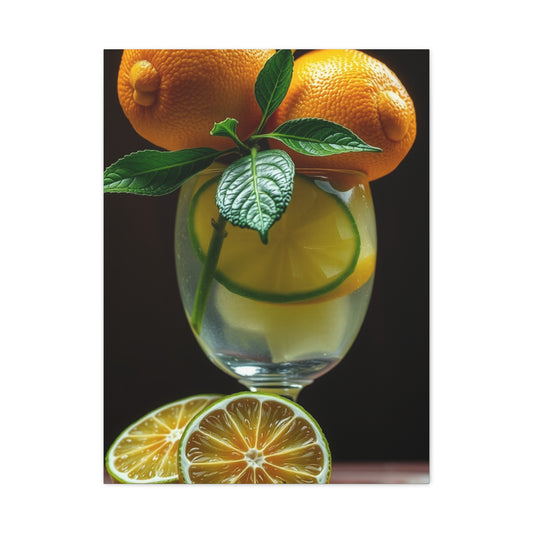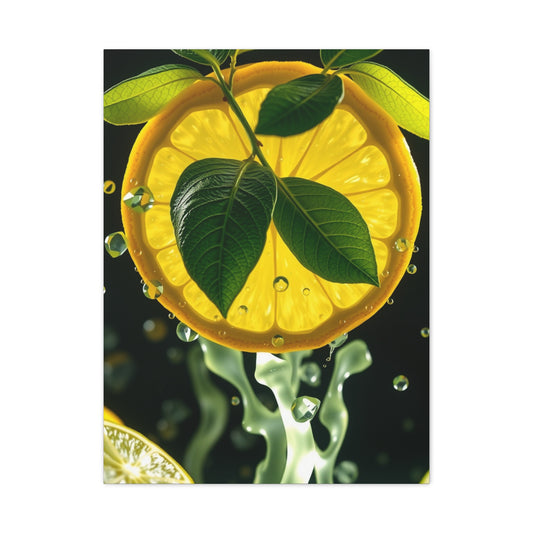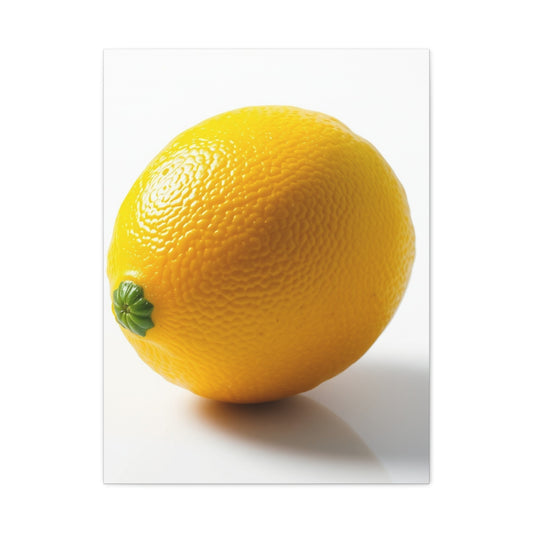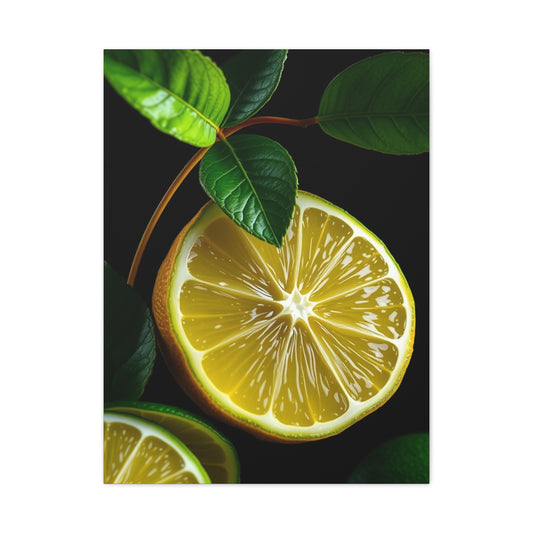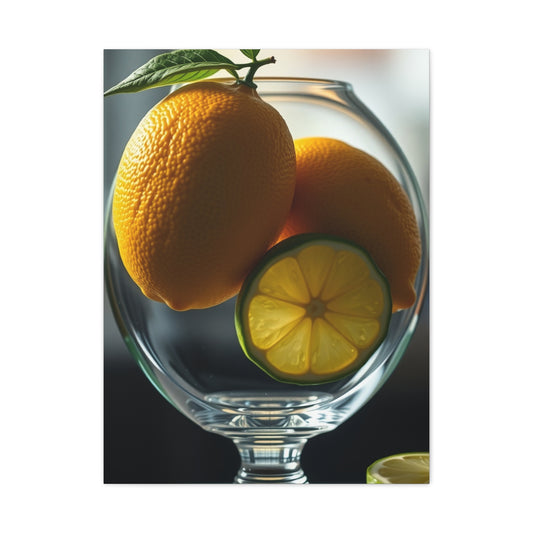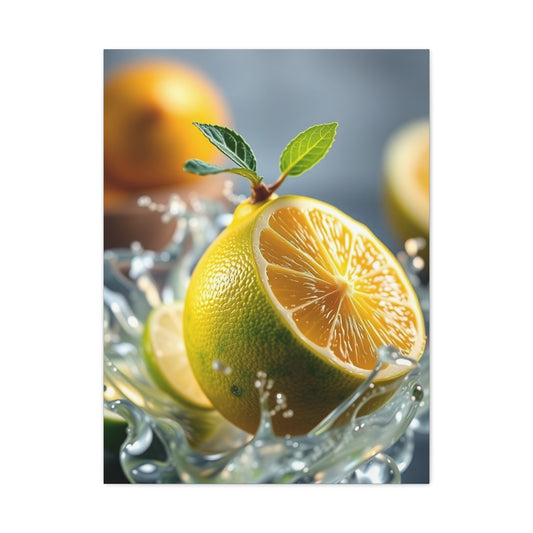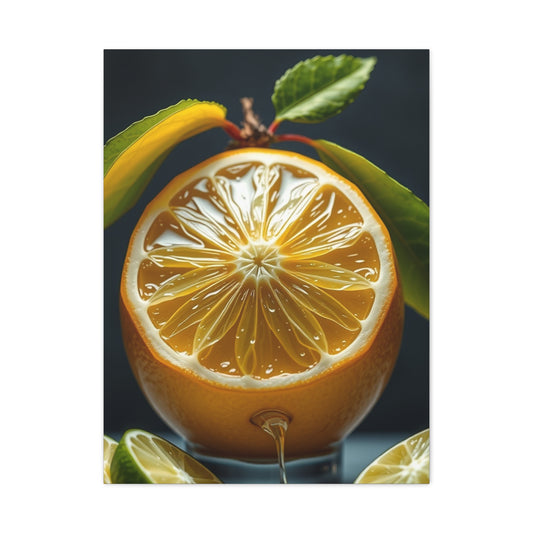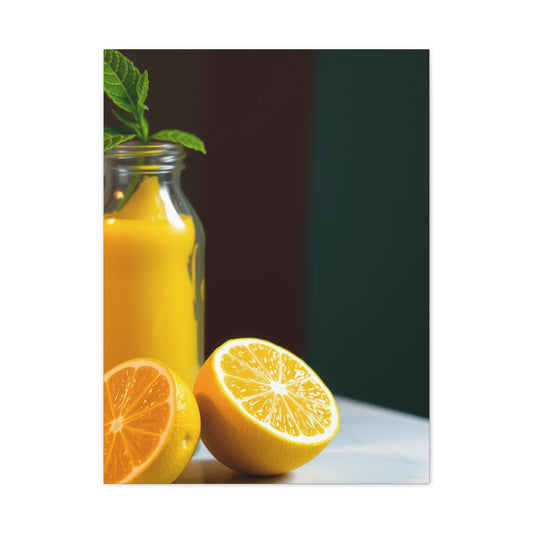Lemon & Lime: Playful Art for Your Walls
Lemon wall decor has blossomed into one of the most invigorating interior trends, finding a home not only in kitchens and dining spaces but also in modern living areas that crave warmth and vibrancy. The lemon, a fruit synonymous with vitality and brightness, brings with it a touch of Mediterranean allure and nostalgic charm. Translating this citrus motif into wall art creates an atmosphere that is simultaneously fresh, joyful, and timeless. Lemon wall art draws from the fruit’s vibrant yellow hues, its delicate blossoms, and the cultural symbolism associated with its zestful character. Whether rendered as hand-painted canvases, photographic prints, rustic metal signs, or three-dimensional sculptural pieces, this motif serves as a design element that awakens the senses and enlivens the spirit of a home.
In interior design, color psychology plays a profound role, and yellow is known for inspiring optimism, energy, and warmth. Lemon wall art takes advantage of this palette, instantly transforming dull walls into radiant focal points. More than just decoration, lemon-themed wall art often becomes a narrative—evoking memories of coastal villages where lemon groves cascade down terraced hillsides, or recalling the sweet aroma of lemonade stands from childhood summers. It adds not only beauty but also symbolic meaning to the environment.
As homeowners increasingly seek ways to personalize their interiors, lemon wall decor has evolved beyond simple prints and into a versatile aesthetic that can adapt to rustic farmhouses, chic urban lofts, vintage cottages, and modern minimalist apartments. Its universal charm ensures that whether displayed as a gallery wall, a large centerpiece, or scattered accents, lemon wall art has the power to make spaces more welcoming, energetic, and soulful.
Historical Background
The relationship between lemons and art stretches far beyond modern interior design. Citrus fruits, particularly lemons, have a long history of being celebrated in artistic and cultural contexts. Their vibrant color and refreshing aroma made them subjects of fascination across civilizations.
In ancient Rome, citrus fruits were considered exotic luxuries, symbols of wealth and health. They appeared in frescoes, mosaics, and decorative motifs, representing abundance and prosperity. The lemon’s golden color aligned with solar imagery, connecting it to vitality, divinity, and illumination. This association carried into the Renaissance, when artists incorporated lemons into still-life paintings to highlight themes of purity, ephemerality, and the richness of nature’s bounty.
During the Baroque era, lemons were frequently depicted in Dutch still-life art. Artists meticulously captured the texture of lemon peel and the translucence of sliced segments, showcasing not just technical skill but also the fruit’s symbolic resonance. Lemons in these works often suggested exoticism, trade, and the fleeting pleasures of life, fitting into the broader “vanitas” tradition that reminded viewers of life’s impermanence.
In Mediterranean culture, especially along the Amalfi Coast of Italy and the coastal towns of Spain and Greece, lemons became ingrained in both daily life and decorative traditions. Hand-painted ceramics often featured lemon motifs, adorning kitchen tiles, pottery, and murals. The lemon groves of Amalfi, Capri, and Sorrento not only supplied fruit but also inspired artisans who translated the sun-soaked imagery into lasting works of art.
By the 19th and 20th centuries, lemon imagery migrated into commercial design. Vintage citrus advertisements, crate labels, and lemonade posters became iconic art forms in themselves, reflecting both agricultural pride and nostalgic charm. Today, these vintage prints are often reproduced as wall art, lending retro flair to kitchens and dining spaces.
Thus, lemon wall decor carries centuries of artistic tradition. It is not merely a passing trend but rather a continuation of a visual language that has evolved across time and place, infusing modern interiors with echoes of history, trade, and cultural symbolism.
Core Concepts and Foundations
At the heart of lemon wall decor lies a fusion of visual appeal, symbolic meaning, and emotional resonance. Understanding why this theme resonates requires examining several foundational ideas:
Color Psychology and Symbolism
Yellow, the dominant hue of lemons, is universally linked to joy, optimism, and clarity. Unlike softer pastel shades or darker tones, bright lemon yellow energizes a room, creating an atmosphere that is cheerful and inviting. The green of lemon leaves introduces balance, grounding the intensity of yellow with freshness and serenity. Together, these colors evoke harmony while stimulating creativity and conversation.
Natural Imagery and Organic Forms
Humans are innately drawn to representations of nature, and lemons—with their round forms, blossoms, and leaves—offer organic shapes that contrast beautifully with the rigid lines of furniture and architecture. Lemon wall art bridges the indoors with the outdoors, bringing a piece of the orchard into the home. This biophilic quality contributes to psychological well-being, making spaces feel more lively and connected to nature.
Cultural and Emotional Resonance
Lemon wall art resonates because it taps into shared memories and cultural associations. For some, it recalls Mediterranean vacations with terraces overlooking groves and coastal waters. For others, it suggests homemade lemonade and warm afternoons. These associations make lemon wall art more than a visual decoration—it becomes a storyteller, weaving emotions into physical spaces.
Versatility of Aesthetic Application
Another core foundation is adaptability. Lemon decor can be interpreted in multiple ways: elegant botanical prints for traditional homes, abstract pop-art styles for modern interiors, rustic metal signs for farmhouse kitchens, or whimsical decals for playful dining rooms. This range of expression ensures lemon art is not confined to a single design philosophy but instead integrates seamlessly across diverse tastes.
Functional Beauty in Everyday Spaces
Beyond symbolism, lemon wall art enhances functionality by transforming kitchens and dining rooms into vibrant gathering places. It aligns with the functional heart of the home by evoking freshness, nourishment, and creativity in culinary pursuits. Unlike more abstract themes, lemon art is grounded in familiar imagery that feels both accessible and uplifting.
Together, these concepts form the foundation of lemon wall decor’s enduring appeal. It is the union of aesthetics, psychology, symbolism, and adaptability that allows this motif to flourish as both art and atmosphere.
Types and Categories
The diversity of lemon wall decor is vast, offering homeowners a spectrum of choices that range from classic to contemporary. Each type carries unique qualities, making it possible to tailor the theme to individual interiors.
Botanical Prints
Detailed botanical illustrations featuring lemons are timeless pieces that highlight the fruit in various stages—from blossoms to ripened fruit. They are perfect for vintage or rustic interiors and pair beautifully with natural wood frames. These prints often appear in sets, creating gallery walls that exude elegance and authenticity.
Canvas Art and Paintings
Hand-painted lemon canvases or printed reproductions provide vibrant focal points. These can range from realistic renderings to impressionistic brushwork or even bold pop-art interpretations. Large-scale lemon canvases work particularly well in kitchens with neutral palettes, where they can inject life and brightness.
Photographic Prints
Photography captures the lemon in all its tactile detail—dewdrops on fresh citrus, lemons in wicker baskets, or styled food compositions. Large-format photographs make striking modern statements, adding sophistication while retaining natural freshness.
Vintage Posters and Advertisements
Retro lemon crate labels, lemonade ads, or citrus festival posters introduce nostalgia and playful charm. These pieces are especially popular in farmhouse or eclectic interiors, where history and storytelling are integral to the design.
Wall Decals and Murals
For a more casual or whimsical approach, removable lemon wall decals or painted murals bring zest to a space. These are versatile, especially in rental apartments or children’s dining nooks, where permanent artwork might not be ideal.
3D Sculptural Art
Metal wall sculptures, ceramic tiles, or wooden reliefs shaped like lemons add depth and texture. Three-dimensional lemon art creates dynamic visual interest, catching light and shadow in ways flat prints cannot.
Mixed-Media Pieces
Some lemon wall decor blends photography, paint, and textured elements into a single artwork. These experimental designs suit modern eclectic homes, offering uniqueness and artistic flair.
By exploring these categories, homeowners can curate wall decor that reflects their personality and complements their chosen interior style.
Practical Applications
The charm of lemon wall art lies not only in its visual beauty but also in its adaptability across different spaces. Its placement and style can dramatically alter the mood of a room.
Kitchens as the Natural Canvas
The kitchen is the most popular setting for lemon wall decor. A large lemon canvas above the breakfast nook, a gallery wall of vintage lemon ads, or botanical prints above a countertop all enhance the culinary heart of the home. Lemon motifs harmonize with both rustic wooden cabinets and modern steel appliances, ensuring versatility across styles.
Dining Rooms Full of Warmth
In dining areas, lemon art can foster an inviting, lively atmosphere. A panoramic lemon mural behind a dining table becomes a conversation starter, while framed prints above a sideboard create balance and elegance. The lemon theme complements natural dining accessories, such as woven placemats and glass vases filled with fresh flowers.
Farmhouse and Cottage Interiors
Lemon wall art thrives in farmhouse and cottage settings. A distressed wooden sign with hand-painted lemons, or ceramic wall plates featuring citrus motifs, enhances the rustic coziness. Paired with gingham textiles and reclaimed wood furniture, lemon art completes the aesthetic with charm and authenticity.
Modern and Minimalist Homes
In sleek, minimalist homes, lemon wall art provides bold pops of color against monochrome backdrops. Abstract lemon paintings or oversized photographic prints work as standalone statement pieces, introducing warmth without overwhelming clean lines.
Commercial Spaces and Cafés
Beyond homes, lemon wall art has found popularity in cafés, juice bars, and restaurants. Its cheerful imagery aligns with spaces dedicated to refreshment and social connection. A lemon-themed mural can reinforce branding while creating an inviting ambiance.
Children’s Playrooms or Creative Corners
For more playful environments, whimsical lemon decals or cartoon-style prints inspire creativity and joy. Their cheerful energy is perfect for spaces where imagination thrives.
Strategic Placement Tips
When applying lemon art, consider scale and lighting. Large pieces should occupy central wall space, while smaller prints can be grouped in clusters. Positioning near natural light enhances the vibrancy of yellows and greens, ensuring the artwork feels luminous. Complementary decor—such as fresh fruit bowls or lemon-patterned textiles—helps unify the theme without overwhelming the room.
Lemon wall decor is more than a decorative choice—it is a celebration of freshness, vitality, and positivity that transforms interiors into radiant sanctuaries. Rooted in centuries of artistic tradition, supported by principles of color psychology and cultural symbolism, and expressed through diverse artistic categories, lemon wall art continues to captivate homeowners seeking warmth and individuality. Its practical applications prove that this cheerful motif belongs not only in kitchens but across homes and even commercial spaces. Above all, lemon wall art embodies the zest of life, turning ordinary walls into extraordinary canvases of joy.
Techniques and Methods
Creating lemon wall decor requires more than selecting pretty prints; it involves thoughtful execution, creative techniques, and a sense of harmony with the space. The methods vary depending on the medium, but all share the aim of translating the vibrancy of citrus into compelling wall art.
One popular method is the use of hand-painted canvases. Artists often employ watercolor for a soft, translucent effect that mirrors the juicy freshness of lemons. Watercolor washes allow for delicate transitions between yellow, green, and white, echoing the fruit’s natural gradients. On the other hand, acrylic paints bring boldness and saturation, making the lemons appear more vivid and lively. Layering techniques, such as glazing or dry brushing, can create texture reminiscent of a lemon’s dimpled skin, adding realism to the artwork.
For those who prefer modern approaches, digital prints have become a versatile option. Designers use graphic software to manipulate photographs of lemons, stylizing them into pop-art patterns or geometric abstractions. These digital artworks can be printed on canvas, paper, or even fabric panels, offering flexibility in both size and texture. Large-format prints serve as impactful statement pieces, while smaller reproductions can be grouped to form cohesive gallery walls.
Murals and wall decals represent another dynamic method. A lemon-themed mural transforms a plain wall into a vibrant tableau. Painted directly onto the surface, murals require techniques such as stenciling for precision or freehand brushwork for artistic flair. Decals, by contrast, offer an accessible, non-permanent alternative. They can be arranged playfully—such as a cascade of lemons climbing a kitchen wall—or strategically positioned to frame furniture or windows.
Three-dimensional lemon decor introduces sculptural artistry. Ceramic tiles shaped like lemons, metal cutouts, or resin reliefs provide tactile depth. These methods rely on craftsmanship, with glazing, casting, and welding techniques used to create durable pieces that catch light and shadow. When placed near windows or under pendant lighting, the textures create shifting impressions throughout the day.
Photography-based lemon art requires its own methods. Photographers often work with controlled lighting to highlight the glossiness of lemon peels or the translucence of sliced fruit. Macro photography captures tiny details—droplets of juice, veins in leaves—that bring viewers closer to the sensory essence of lemons. Post-editing techniques such as enhancing saturation or adjusting contrast ensure the imagery feels as bright and zesty as the subject itself.
Mixed-media techniques expand the boundaries further. Combining elements like vintage text overlays, textured papers, or fragments of fabric with painted lemons creates layered artwork rich in dimension. Collage and assemblage methods are particularly effective for eclectic interiors, where imperfection and creativity reign.
The unifying principle across all methods is intentionality. The choice of technique should align with the room’s atmosphere. A rustic kitchen may benefit from hand-painted wooden lemon signs, while a sleek dining space calls for large photographic prints. By selecting the right method and executing it with care, lemon wall decor evolves into more than ornamentation; it becomes an expressive piece of interior storytelling.
Challenges and Common Mistakes
While lemon wall art may appear straightforward, there are several pitfalls homeowners and decorators encounter when attempting to integrate this lively motif. Recognizing these challenges ensures the final design feels cohesive rather than chaotic.
One common mistake is over-saturation of the theme. Lemons are naturally bold, and when every surface—from wallpaper to curtains—echoes the motif, the effect becomes overwhelming rather than refreshing. The challenge lies in moderation: balancing focal pieces of lemon wall decor with more neutral or subtle backgrounds so the motif feels intentional rather than excessive.
Another frequent issue is poor color coordination. While yellow is energizing, it can clash with certain palettes if not carefully balanced. For instance, placing lemon wall art against a neon or overly bright backdrop may create visual strain. The better approach is to pair lemon imagery with whites, soft greens, or natural wood tones, which allow the yellow to shine without competing.
Scale misjudgment is another obstacle. Oversized lemon art may dominate a small kitchen, making it feel cramped, while tiny prints on a large wall risk appearing lost and insignificant. Considering the proportion relative to wall size and surrounding furniture is crucial to maintaining visual harmony.
Placement mistakes also undermine the impact of lemon wall art. Hanging artwork too high or low disrupts natural sightlines, while placing decor in poorly lit corners diminishes its vibrancy. Since lemon imagery thrives on brightness, poor lighting can strip it of its cheerful effect. Ensuring natural light or strategic artificial illumination enhances the artwork is essential.
A more subtle challenge involves mismatched styles. A hyper-realistic lemon photograph may feel out of place in a rustic farmhouse kitchen, just as a distressed vintage lemon sign may jar against minimalist modern interiors. Selecting decor that resonates with the broader design language of the room prevents aesthetic dissonance.
Another mistake lies in neglecting the artwork’s quality. Low-resolution prints, flimsy decals, or poorly made replicas reduce the sophistication of the design. Lemon wall art is most effective when crafted with care—whether through durable materials, professional printing, or thoughtful framing. Investing in quality ensures the motif feels intentional rather than kitschy.
Lastly, homeowners often forget the importance of balance between permanence and flexibility. A painted mural, though striking, may feel restrictive if tastes change or the home is rented. Decals or framed pieces offer adaptability, allowing for updates without extensive renovation. Avoiding permanent commitments when unsure of long-term preferences is a wise strategy.
By acknowledging these challenges and avoiding common missteps, lemon wall art can fulfill its potential as a timeless and joyful addition rather than an overbearing design choice.
Trends and Future Outlook
Design trends evolve with cultural shifts, and lemon wall decor is no exception. What began as a charming motif for kitchens has grown into a versatile element across diverse spaces, reflecting broader movements in interior design.
One current trend is the blending of natural and digital aesthetics. Artists are experimenting with hyper-realistic photographic lemon prints enhanced by digital manipulation—adding unexpected color gradients, abstract patterns, or layered textures. This fusion reflects the contemporary desire for authenticity paired with innovation.
Sustainability is another powerful trend shaping the future of lemon wall decor. Consumers increasingly seek eco-friendly materials, from recycled wood frames to biodegradable inks. Handcrafted lemon art created by local artisans is gaining popularity, not only for its uniqueness but also for its reduced environmental footprint. Lemon motifs painted on reclaimed wood or printed on organic fabrics align with the ethos of conscious living.
The trend of maximalism has also expanded opportunities for lemon decor. In contrast to minimalist approaches, maximalism embraces bold patterns, layered visuals, and striking contrasts. Lemon wall art fits beautifully into this aesthetic, especially when combined with other botanical or fruit motifs to create rich, immersive environments.
Personalized and customizable lemon art is another emerging direction. With digital printing technology, homeowners can now commission custom pieces—such as lemon art combined with personal family recipes, quotes, or stylized photographs. This personalization deepens the connection between the artwork and the individual space, making lemon decor uniquely meaningful.
In terms of placement, the trend of expanding beyond kitchens is reshaping Lemon Art’s role. Designers are introducing lemon motifs into living rooms, sunrooms, bathrooms, and even office spaces. The fruit’s bright character works equally well in leisure and productivity zones, offering energy and optimism across diverse environments.
Looking to the future, we can anticipate lemon wall decor evolving through interactive design. With the rise of smart homes, digital art frames may allow lemon-themed artworks to change dynamically, cycling through different styles or adapting to the room’s lighting and mood. Augmented reality could also make lemon art more experiential, with walls coming alive through projected citrus blossoms or animations.
Globally, the lemon motif will likely continue to resonate because of its universal symbolism of vitality and warmth. As interior design trends embrace both personalization and sustainability, lemon wall art is poised to remain a beloved element, continually refreshed through innovative interpretations.
Expert Insights
Interior designers and artists often highlight lemon wall decor as a rare motif that balances playfulness with sophistication. Experts suggest that its enduring appeal lies in the fruit’s ability to embody both timeless natural beauty and contemporary vibrancy.
Designers frequently recommend starting with one statement piece of lemon wall art and building the room’s accents around it. This ensures cohesion without overcrowding the space. For example, a large lemon canvas can dictate complementary textiles, such as striped dish towels or pale green cushions, without repeating the fruit motif excessively.
Experts also emphasize the importance of framing. The right frame can elevate even the simplest lemon print. A distressed wooden frame enhances rustic charm, while sleek black or metallic frames lend modern elegance. Designers encourage experimenting with unconventional frames, such as circular or asymmetrical ones, to echo the playful roundness of lemons.
Artists working with lemon imagery note its adaptability across media. A watercolorist may focus on translucence and softness, while a sculptor highlights texture and form. This diversity ensures that lemon wall art never feels repetitive; instead, it evolves with the vision of each creator.
Psychologists consulted on the subject often point out the therapeutic qualities of lemon decor. Yellow tones are believed to stimulate the brain, increase energy, and foster positivity, while green evokes calmness and balance. The pairing is considered ideal for kitchens and dining spaces, where both energy and relaxation are desired.
From a cultural perspective, lemon art experts highlight its ability to transcend borders. While rooted in Mediterranean traditions, lemon motifs are equally cherished in American farmhouse aesthetics, Asian fusion interiors, and contemporary European designs. Its adaptability across cultures suggests that lemon wall art is not merely a fleeting trend but a global design language.
Looking ahead, experts predict that lemon wall decor will continue to thrive as long as homeowners seek joy and vibrancy in their interiors. The motif’s versatility ensures it can be continually reinvented, whether through bold maximalist interpretations, minimalist elegance, or sustainable handmade craftsmanship.
Ultimately, the consensus among experts is clear: lemon wall art embodies more than visual beauty. It reflects optimism, warmth, and the universal longing for spaces that uplift and nurture. By thoughtfully selecting, placing, and styling lemon-themed decor, homeowners can harness the enduring power of this citrus muse.
Lemon wall decor is not just a fleeting design fad but a rich and versatile art form supported by thoughtful techniques, creative execution, and timeless appeal. While challenges such as over-saturation, poor placement, and mismatched styles can hinder its impact, mindful approaches ensure its success. Current trends point toward sustainability, customization, and cross-room adaptability, while future outlooks envision digital integration and interactive design. Expert insights further affirm its psychological and cultural resonance, marking it as a motif that balances cheerfulness with elegance.
Emerging Trends in Wall Art
Wall art has always been a reflection of cultural evolution, and the latest trends reveal a shift toward designs that merge personal expression with sustainability, adaptability, and sensory engagement. Lemon wall art fits within this larger movement, embodying themes of freshness, vibrancy, and natural simplicity while staying relevant across multiple design contexts.
One of the strongest trends is the rise of biophilic design, which emphasizes nature-inspired decor. Homeowners are seeking ways to connect indoor spaces with the organic beauty of the outdoors. Lemon imagery, with its lush foliage and sunny fruit, represents an ideal motif for biophilic interiors, creating a refreshing and invigorating connection between daily life and the rhythms of nature.
Customization has also become central to contemporary wall art. Rather than selecting mass-produced prints, people are gravitating toward bespoke artworks tailored to their homes. In the context of lemon decor, this means personalized prints with family names, recipe illustrations featuring lemons, or handcrafted canvases painted by local artists. Such personalization adds narrative depth and makes lemon wall art not only decorative but also deeply meaningful.
Digital integration is another emerging dimension. Smart digital frames now allow art to rotate, adapt, or transform based on mood and lighting. Lemon wall art in digital form can shift from a vintage print in the morning to a bold abstract piece in the evening, offering flexibility for dynamic interiors. This adaptability resonates with homeowners who want their spaces to evolve with their emotions and activities.
Sustainability continues to shape consumer choices. Lemon motifs painted on reclaimed wood, eco-friendly canvases, or recycled metal signs reflect a growing desire to decorate responsibly. This trend extends to artisan craftsmanship, with many preferring handmade lemon decor that supports local makers and reduces environmental impact.
Additionally, maximalism has revived bold and vibrant wall designs. Lemon art is particularly suited for this trend, where oversized canvases, gallery walls filled with citrus imagery, and layered textures create exuberant environments. The lemon’s inherent brightness makes it a natural candidate for bold interiors that celebrate color, energy, and abundance.
Together, these emerging trends indicate that lemon wall art is not just part of a decorative fad. It aligns with long-term movements that value connection to nature, personalization, adaptability, sustainability, and visual joy. These values ensure its continued popularity and versatility across evolving styles.
Step-by-Step Guide: Choosing Lemon Wall Art
Selecting the right lemon wall art is a process that combines aesthetic judgment, functional considerations, and personal taste. To achieve a harmonious outcome, homeowners can follow a deliberate step-by-step approach.
Step 1: Identify the Purpose of the Space
Begin by reflecting on the function of the room. In kitchens, lemon art often emphasizes freshness and nourishment, while in dining rooms it sets a convivial, welcoming mood. For living rooms or offices, lemon art may serve as an energizing focal point. Knowing the purpose of the space will guide the scale, style, and tone of the artwork.
Step 2: Evaluate the Color Palette
Examine existing colors in the room before choosing wall art. Lemon motifs pair beautifully with whites, grays, greens, and natural wood tones. In rooms with darker palettes, lemon art acts as a bright contrast, while in light interiors it amplifies the sense of airiness. Harmonizing the artwork with surrounding hues prevents visual discord.
Step 3: Decide on the Artistic Style
Choose a style that matches the broader decor. Botanical prints suit traditional or rustic interiors, while bold abstract lemon paintings enhance modern minimalism. Vintage posters align with farmhouse or retro settings, and playful decals fit casual or eclectic spaces. Matching the style of lemon art with the room’s personality ensures cohesion.
Step 4: Consider Scale and Placement
Measure the wall area to determine the appropriate size. A large canvas above a dining table or kitchen island creates a bold focal point, while smaller prints grouped suit narrower walls. Always leave breathing space around the art so it integrates gracefully into the environment rather than overwhelming it.
Step 5: Focus on Quality
Opt for durable materials, high-resolution prints, or hand-painted pieces. Lemon art thrives on clarity and vibrancy, which can be diminished by poor-quality reproductions. Frames, textures, and finishes should be chosen to complement both the artwork and the room’s existing design.
Step 6: Integrate Complementary Decor
Finally, consider accents such as lemon-patterned textiles, fruit bowls, or green foliage to echo the wall art without creating redundancy. Subtle repetition of motifs ensures the theme feels intentional and immersive.
By following these steps, homeowners can curate lemon wall art that enhances both the beauty and the spirit of their interiors.
Step-by-Step Guide: DIY Lemon Wall Decor
For those who enjoy hands-on creativity, crafting lemon wall art at home offers a fulfilling way to infuse personal character into a space. Here’s a step-by-step guide for a simple yet striking project.
Step 1: Gather Materials
Select a blank canvas or wooden board as your base. Prepare acrylic paints in shades of yellow, green, and white, along with brushes of varying sizes. A stencil of a lemon shape can assist beginners, while freehand drawing works for those with more confidence.
Step 2: Prepare the Surface
If using a wooden board, sand it to a smooth finish and apply a base coat of white paint. A canvas can be primed with gesso to ensure smooth application of colors. Allow the base to dry fully before painting.
Step 3: Sketch the Design
Lightly sketch lemon shapes using a pencil. Decide whether to depict whole lemons, slices, or a combination. Adding leaves or blossoms creates a more dynamic composition. Arrange the elements to balance the canvas.
Step 4: Apply Base Colors
Paint the lemons with a bright yellow base. Use lighter strokes in the center to suggest highlights and darker tones near the edges for shading. The leaves should be painted in varied greens to add depth and realism.
Step 5: Add Details
Enhance the lemons with textured brushstrokes to mimic their dimpled skin. Include small white highlights to create the illusion of gloss. Flowers can be painted in soft whites and pinks, with delicate strokes for petals.
Step 6: Seal the Artwork
Once the painting is dry, apply a protective varnish to preserve the vibrancy of the colors and protect against dust. If mounted on wood, sealing ensures durability.
Step 7: Display Thoughtfully
Hang the finished piece in a well-lit area, ideally near natural light, to enhance its cheerful tones. Complement with subtle lemon-themed accents to reinforce the motif.
This process not only creates personalized lemon wall decor but also deepens the emotional connection to the space, as the artwork reflects the maker’s creativity and care.
Step-by-Step Guide: Styling with Lemon Art
Incorporating lemon wall decor into an interior requires more than simply hanging it on the wall. Styling ensures that the artwork feels integrated, cohesive, and impactful.
Step 1: Establish a Focal Point
Choose one wall or section of a room where lemon art will stand out. Avoid spreading pieces randomly; instead, curate a focal area such as above a fireplace, dining table, or kitchen island.
Step 2: Layer with Textures
Combine the wall art with complementary textures like linen curtains, wicker baskets, or ceramic dishware. Textures echo the natural theme of lemons and prevent the space from feeling flat.
Step 3: Echo Colors Subtly
Introduce yellow accents through cushions, rugs, or tableware. Ensure these touches are restrained to avoid overwhelming the room. Subtle repetition ties the theme together without excess.
Step 4: Balance with Neutrals
Pair lemon wall art with neutral backgrounds—whitewashed walls, pale cabinetry, or natural wood furniture. This balance allows the artwork to shine without competing elements.
Step 5: Incorporate Nature
Fresh greenery, potted herbs, or even bowls of real lemons enhance the authenticity of the motif. Living elements reinforce the organic beauty captured in the artwork.
Step 6: Adjust Lighting
Use lighting to highlight lemon art. Pendant lights in kitchens or sconces in dining rooms can cast flattering illumination, ensuring the yellows appear luminous rather than muted.
Step 7: Create Continuity
Carry the lemon theme into adjacent spaces with subtle echoes, such as a lemon-patterned tea towel or small framed prints in a hallway. This continuity creates flow throughout the home.
By styling with intention, lemon wall art becomes part of a larger narrative rather than a disconnected accessory.
Emerging trends in wall art reveal a clear direction toward natural inspiration, customization, sustainability, and digital innovation, with lemon motifs fitting seamlessly into each of these movements. Step-by-step guides for selecting, creating, and styling lemon wall art highlight the thoughtful decisions required to achieve a cohesive design. By understanding purpose, scale, and balance, homeowners can transform ordinary spaces into cheerful sanctuaries that celebrate freshness and vitality.
Refreshing yet Fun Lemon Wall Decor Ideas
Techniques and Methods
The creation of lemon wall decor demands a balance of artistic intuition, technical skill, and thoughtful planning. Techniques vary depending on whether the piece is hand-painted, digitally designed, crafted as a decal, or assembled from mixed materials. Each method contributes distinct qualities to the final appearance and influences how the artwork integrates with surrounding interiors.
Painting remains one of the most time-honored techniques. Acrylics and oils allow artists to render the vibrant hues of lemons with great depth, capturing the interplay of light and texture on their dimpled skin. Watercolors, by contrast, produce softer, translucent interpretations that evoke freshness and subtlety. The method chosen dictates the mood of the room, with bold acrylics generating energy and delicate watercolors offering calmness.
Printmaking techniques also play a significant role in contemporary lemon wall art. Screen printing, lithography, and block printing create sharp, repeatable designs that work well for patterned walls or framed collections. Such methods emphasize rhythm and repetition, often aligning with more modern or eclectic interiors. The tactile quality of prints gives a handcrafted character that resonates with viewers seeking authenticity.
Digital design techniques introduce another dimension. Artists can now create lemon motifs using graphic design software, which can then be reproduced on canvases, wallpapers, or even illuminated digital frames. This method allows unlimited experimentation with color saturation, stylization, and composition. The digital approach offers both precision and flexibility, ensuring artwork can be adapted to diverse spaces.
Mixed-media methods combine multiple approaches for richer textures. For instance, lemons painted on reclaimed wood panels produce a rustic aesthetic, while decoupage techniques using printed paper and paint layering evoke playful creativity. Some designers incorporate fabric or thread embroidery over painted backgrounds, blurring boundaries between art and craft. These hybrid techniques encourage uniqueness, as each piece reflects individual craftsmanship.
Murals represent one of the most immersive techniques. Large-scale lemon murals painted directly onto walls can transform entire environments. Whether realistic or abstract, murals establish lemon imagery not as an accessory but as a central architectural feature. Their scale makes them suitable for kitchens, dining rooms, or outdoor patios, where they create instant visual drama.
Each method holds its own charm, and the best choice depends on personal preference, skill, and the intended atmosphere. What unites these approaches is the careful handling of detail, color balance, and compositional harmony—elements essential to ensuring that lemon wall decor enhances rather than overwhelms a space.
Challenges and Common Mistakes
While lemon wall art offers tremendous potential for beauty and vibrancy, certain challenges frequently arise during its selection, creation, and styling. Recognizing these pitfalls helps homeowners and creators avoid missteps that might diminish the intended impact.
One common mistake is poor scale management. Oversized artwork placed in a small space can feel oppressive, while pieces too small for expansive walls may appear insignificant. Finding proportional balance is crucial for creating visual harmony. Measuring the available wall space before acquiring or designing lemon art prevents disproportionate results.
Another issue lies in color imbalance. Although yellow is naturally uplifting, excessive saturation without supporting tones can overwhelm the eye. Some decorators make the mistake of combining lemon art with equally bold colors, leading to visual dissonance. The solution lies in pairing the bright motif with neutral or natural hues, ensuring that the artwork remains the star without clashing with its surroundings.
Quality inconsistency also emerges as a frequent challenge. Low-resolution prints, flimsy frames, or fading pigments can cheapen the overall effect of lemon decor. Since the motif depends on clarity and vibrancy, investing in durable materials and skilled craftsmanship is essential to preserve both visual appeal and longevity.
In DIY projects, technical difficulties often occur. Uneven brushstrokes, poorly sealed surfaces, or misaligned stencils can compromise the finished piece. Beginners sometimes neglect to prime surfaces properly, causing paint to peel or fade prematurely. Taking time to prepare, practice, and finish with protective coatings mitigates these problems.
Styling mistakes also affect outcomes. Some decorators attempt to pair lemon wall art with too many other fruit or floral motifs, creating visual clutter. Others position the art in areas with poor lighting, which diminishes the vibrancy of the yellow tones. Strategic placement, selective theming, and thoughtful illumination all ensure that lemon decor retains its intended freshness.
Another subtle challenge arises when themes are applied too literally. Using lemon imagery in every corner of a kitchen, for example, may feel kitschy rather than elegant. The goal is to strike a balance where the lemon motif feels like a design narrative rather than a repetition of objects. Moderation ensures timelessness.
By understanding these challenges, decorators and creators can take preventative measures, ensuring their lemon wall decor feels polished, cohesive, and enduring.
Trends and Future Outlook
The trajectory of wall art continues to evolve, shaped by cultural sensibilities, technological innovation, and ecological awareness. Lemon wall art, though rooted in classic motifs, adapts well to these emerging directions and is expected to remain relevant far into the future.
One trend influencing lemon decor is the increasing integration of tactile art. Walls are no longer seen purely as visual surfaces but as opportunities for multisensory engagement. Lemon motifs may appear in textured relief panels, woven wall hangings, or sculptural ceramics mounted on walls. This tactile dimension deepens interaction, making art not only seen but also felt.
Another direction lies in immersive digital experiences. With advancements in projection mapping and interactive displays, lemon imagery could evolve into moving, dynamic installations. Imagine a kitchen wall that shifts from morning sunlight filtering through lemon branches to an evening scene of glowing citrus lanterns. Such dynamic adaptations promise to keep interiors continually refreshed.
Sustainability will continue to dominate the future of wall art. As awareness grows around eco-friendly materials, lemon decor will likely appear on recycled canvases, biodegradable wallpapers, or reclaimed wooden boards. Artists committed to ethical practices will ensure that the charm of citrus imagery aligns with environmentally conscious values.
Global cultural influences are also shaping the future of motifs. Lemon imagery has long associations with Mediterranean aesthetics, but cross-cultural interpretations are emerging. Japanese minimalism may portray lemons through simple ink brushstrokes, while Latin American vibrancy may depict them in bold folkloric patterns. Such diverse perspectives will broaden the appeal of lemon wall art across different audiences.
Minimalism and maximalism will both coexist in future trends. Some interiors will favor a single, understated lemon sketch as a subtle accent, while others will embrace expansive gallery walls filled with diverse interpretations of citrus. This flexibility ensures that the motif remains adaptable regardless of shifting style preferences.
Another trend is personalization through technology. Customized digital platforms will allow homeowners to upload family recipes or personal quotes integrated into lemon art prints. Augmented reality may even allow viewers to interact with artwork, seeing lemons blossom or shift with a tap of a phone screen.
The future outlook suggests that lemon wall decor will not only endure but expand into new creative territories. Its symbolic freshness, cultural versatility, and adaptability to modern technologies make it a timeless motif with boundless potential.
Expert Insights
Designers and artists frequently emphasize that lemon wall art succeeds because of its universal resonance. The motif symbolizes vitality, optimism, and simplicity—qualities that resonate deeply across cultures. Experts agree that the key to successful application lies in intentionality. Rather than scattering lemon art randomly, they suggest curating it as part of a broader interior story.
Interior stylists often recommend starting with one central piece—a striking canvas, mural, or framed print—and then layering smaller accents around it. This approach ensures coherence rather than clutter. They highlight that lighting plays a pivotal role; natural daylight enhances the yellow hues, while soft evening lighting prevents glare.
Artisans working with sustainable materials stress the importance of supporting local craftsmanship. Hand-painted lemon panels or screen-printed fabrics produced by local makers not only enrich the decor but also contribute to community economies. Experts view this trend as both aesthetically rewarding and socially responsible.
From a psychological perspective, color specialists explain that yellow, when used thoughtfully, stimulates joy and focus without inducing restlessness. When paired with greens or whites, lemon wall art creates an atmosphere conducive to relaxation and productivity. This insight underlines why lemon motifs suit kitchens, dining spaces, and work areas alike.
Digital designers bring another perspective, noting how lemon motifs can be easily adapted into customizable prints. They encourage homeowners to explore digital platforms that allow real-time adjustments to size, color, and framing before ordering. This minimizes errors and ensures that the final product fits seamlessly into the chosen space.
Experts consistently advise moderation. The enduring appeal of lemon wall art lies not in excessive repetition but in selective placement that allows each piece to shine. A single oversized print may hold more impact than a wall crowded with smaller images. This restraint reflects a growing appreciation for balance in modern interiors.
Conclusion
The exploration of lemon wall decor across techniques, challenges, trends, and expert insights reveals that this motif is both timeless and forward-looking. Its success lies in its ability to embody freshness, vibrancy, and natural beauty while adapting to evolving artistic and cultural contexts.
The techniques available—ranging from painting and printmaking to digital design and mixed media—offer endless possibilities for personalization. Each method contributes unique textures, tones, and moods, allowing homeowners to select or create art that resonates with their individual sensibilities. Yet alongside creative opportunities come challenges. Misjudging scale, color balance, or placement can diminish the impact of lemon decor, reminding us that thoughtful planning is just as crucial as artistic expression.
Emerging trends point toward a future where lemon art is increasingly interactive, sustainable, and culturally diverse. Its adaptability to both minimalist and maximalist aesthetics ensures longevity, while advances in technology open doors for dynamic, immersive experiences. Expert perspectives further validate that success depends on intentionality, moderation, and integration into a broader narrative of home design.
Ultimately, lemon wall art transcends decoration. It carries symbolic resonance, practical adaptability, and aesthetic joy. By merging creativity with careful execution, it transforms walls into vibrant expressions of life’s zest. For homeowners, artists, and designers alike, it represents not merely an accessory but a vital element of interior storytelling—one that refreshes spaces, elevates moods, and celebrates timeless simplicity.

